Family : Gobiidae

Text © Giuseppe Mazza

English translation by Mario Beltramini
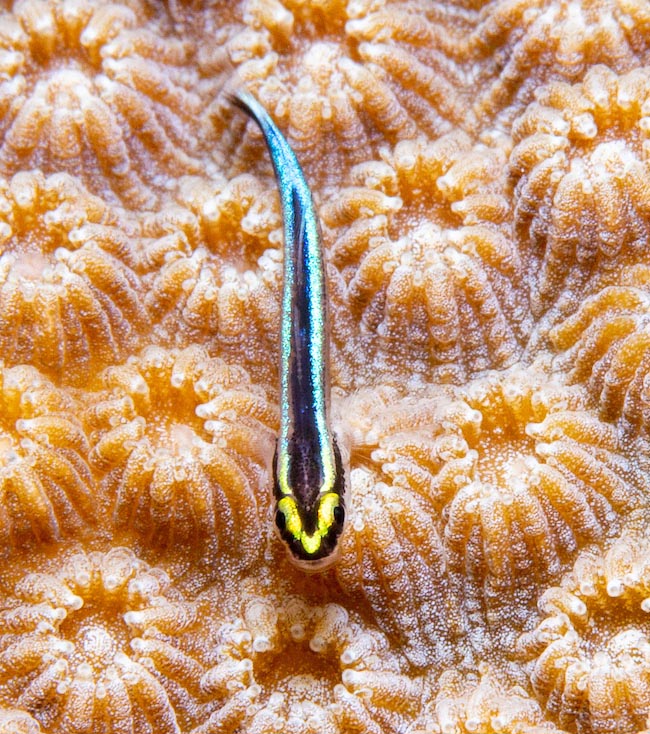
4 cm long at most, with a characteristic V on the head, Elacatinus evelynae is one of the smallest extant fishes © Allison & Carlos Estape
The Sharknose goby, Elacatinus evelynae (Böhlke & Robins, 1968), belongs to the class of the
Actinopterygii, the ray-finned fishes, to the order of the Gobiiformes and to the Gobiidae, the greatest family of marine fishes rich of about 2000 species.
Animals usually measuring less than 10 cm, reaching at most one half of a metre, and that boast the smallest extant vertebrates, like the famous Gobiodon okinawae, often present as a curiosity in the aquaria, who does not exceed 3,5 cm.
The name of the genus Elacatinus, created by Jordan in 1904, originates, Latinized, from the old Greek, with the term once used for the spindle-shaped fishes preserved in salt.
Conversely, the specific name evelynae, of Evelyn in Latin, is a tribute from the Author to Lady Evelyn Mc Cutcheon (1894-1977), “gracious mistress of Treasure Island”, who hosted him for several years in the Bahamas during his research.
The vulgar name of Sharknose goby, originates instead from the shape of its pointed snout, with the mouth opening on the lower side of the body like the sharks.
Zoogeography
Elacatinus evelynae is a Caribbean fish present in western Atlantic: from Bahamas, Belize and Honduras to Cuba, Jamaica, Haiti, Dominican Republic, Puerto Rico and the Lesser Antilles up to the northern coast of South America.
Ecology-Habitat
The Sharknose goby frequents the clear waters of the madreporic formations up to about 50 m of depth, moving over madrepores or sponges, well,visible in the sites known as “cleaning stations”, where fishes go to get the skin parasites removed.
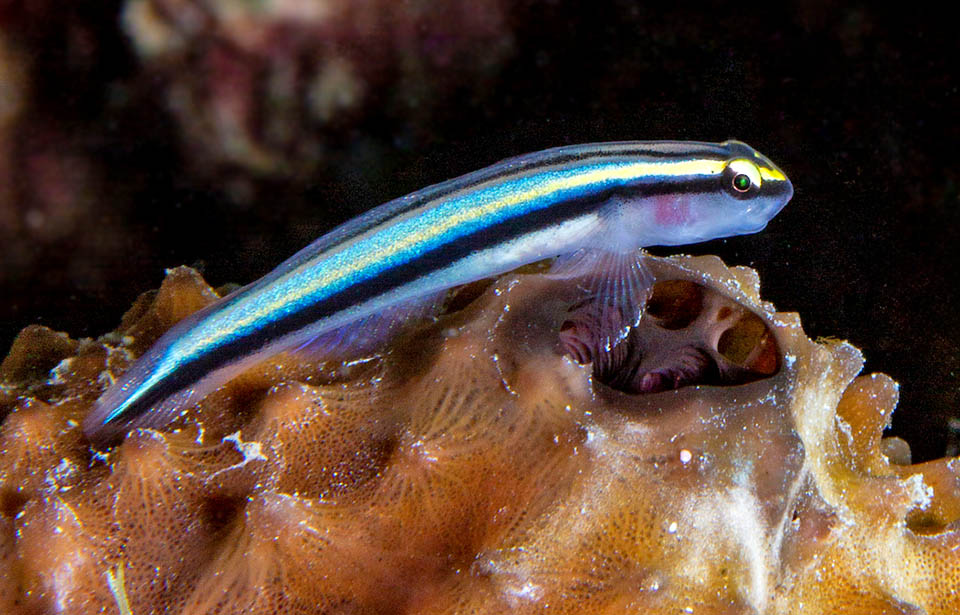
Lives in the Caribbean and is known as Sharknose goby, due to the sharp snout with the mouth located below like the sharks © Allison & Carlos Estape
The madrepores it chooses as home, where to settle easily without the risk of being dragged by the waves, are the star corals of the genus Montastraea, the Lettuce coral (Agaricia agaricites) and the Mustard hill coral (Porites astreoides), but lives also over gaudy sponges such Aiolochroia crassa with its colourful yellow, orange, green or violet columns.
Easy reference points for the passing by clients, showy eye-catching signs for its ambulatory room located below, where also the normally aggressive fishes like groupers and morays come in peace, mouth open, to get their skin, gills cleaned and the food leftovers removed.
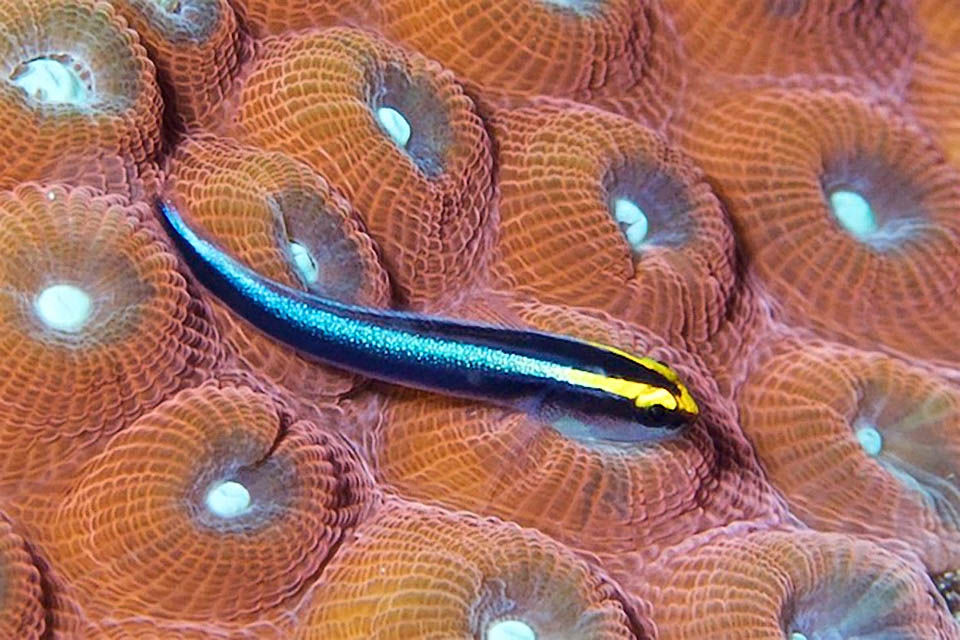
Depending on the zone, it has three colour variants. This is the yellow and blue one, the most diffused © Allison & Carlos Estape
Nothing better, for this purpose, than a thin small spindle-shaped fish, like the Sharknose goby.
Morphophysiology
Elacatinus evelynae reaches a maximum of 4 cm in length. On the black coloured background with the pale ventral side do exist, depending on the geographic zone, three variants of colour having in common a V-shaped design on the head.
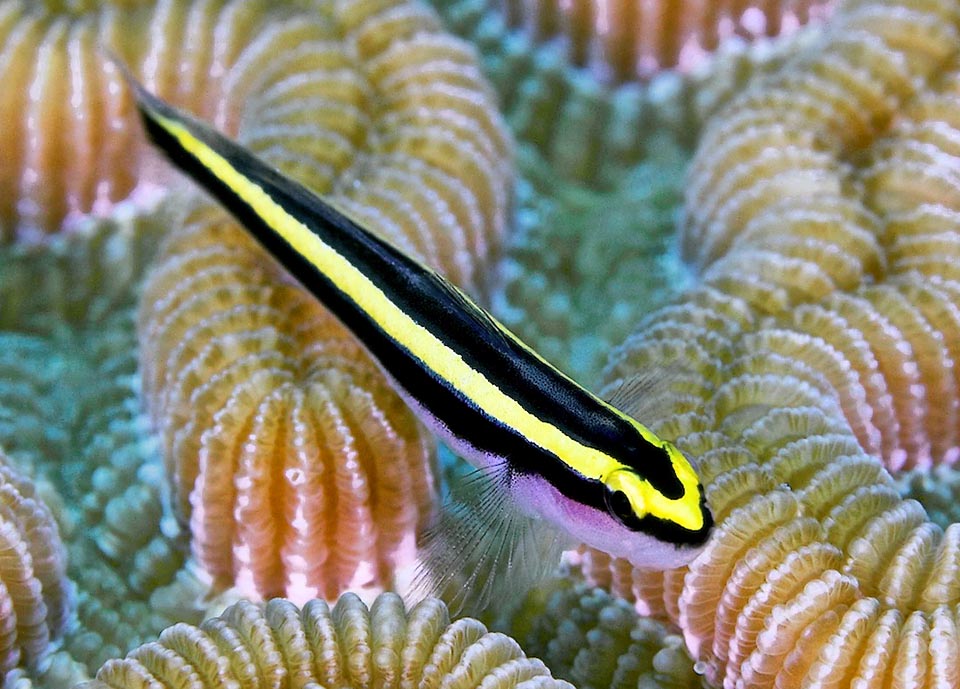
In yellow variant the V of the head goes on the sides up to the tail with golden bands on black background. In all liveries the belly is always clear © Allison & Carlos Estape
The yellow variant, characterized by the V-shaped design crossing the upper part of the eyes and then continuing with a long band on the sides up to the caudal fin, lives northeast of the Bahamas starting from Little Bahama Bank off Florida up to Nassau and the Eleuthera Islands.
The yellow and blue variant, with analogous drawing but with the yellow fading to blue just after the head, is that having the largest range, from central and southern Bahamas throughout much of the eastern Caribbean up to beyond Puerto Rico, Virgin Islands and the Lesser Antilles to end in Barbados, Margarita Island, Los Roques, Bonaire and Curaçao.
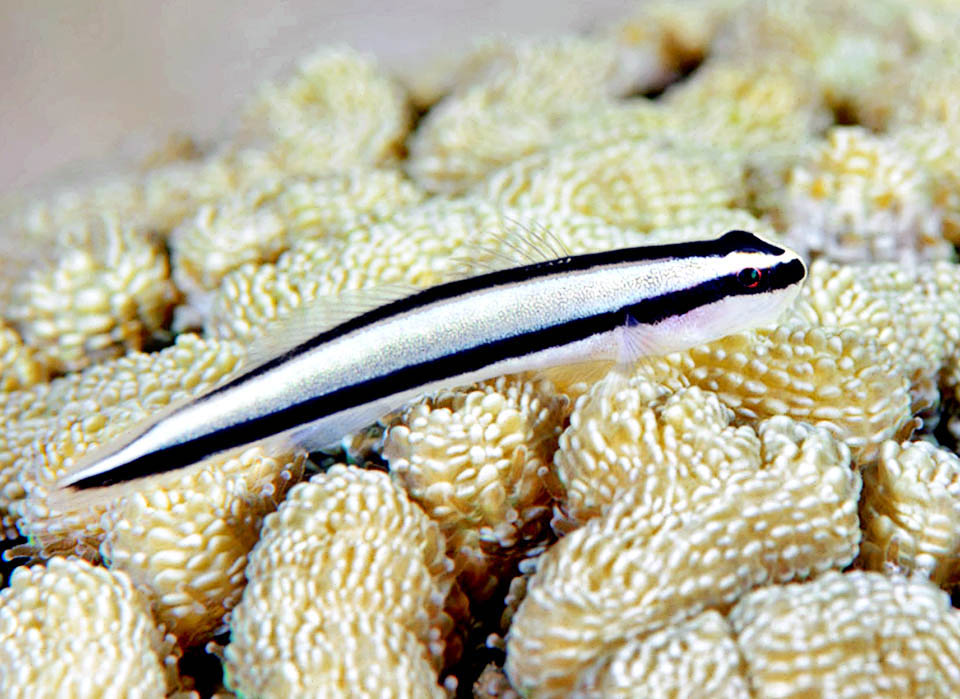
The white variant, with wider band, is the least frequent and some venture that we could speak of three species © Wolfram Sander
The white variant, with the white design on the head and wide lateral bands having the same colour, is the rarest, mainly present in Jamaica and, southwards, up to the islands of Providencia and San Andrés.
The structure of the body however remains the same. Elacatinus evelynae has two dorsal fins: the first with 7 spiny rays and the second with 12 soft; the anal has also 1 spiny ray and 11-12 unarmed, the pectoral and the caudal ones are rounded and the ventral have merged into the characteristic sucker of the gobies that serves to anchor on the substratum so as not to be carried away by the currents and settle, in our case, on the body of the patients. There is no lateral line and the mouth has tiny conical teeth.
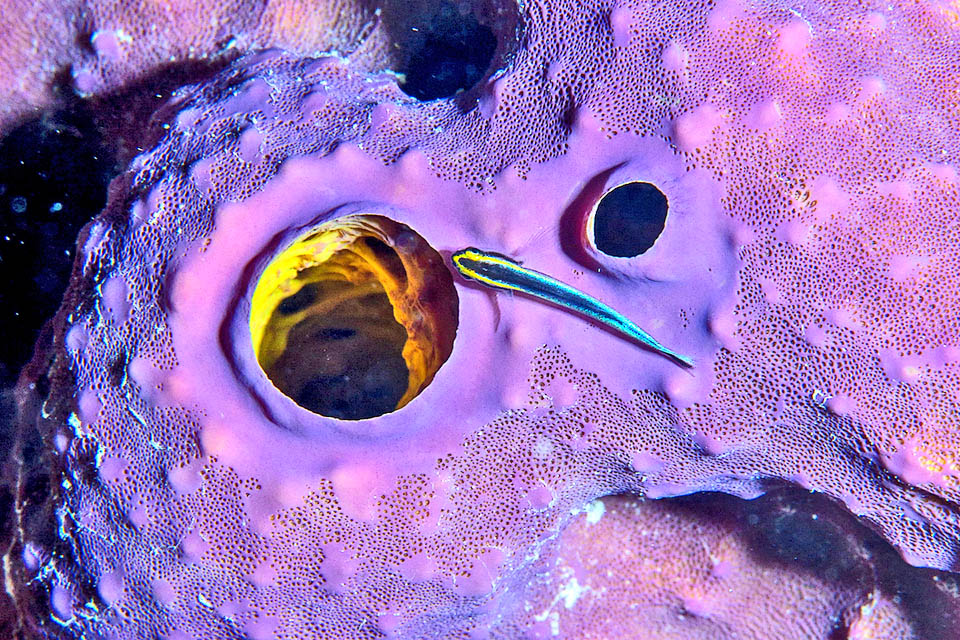
Elacatinus evelynae eats madreporic polyps, sponges, sea squirts, bryozoans and zooplankton, but chiefly ectoparasites, mucus and the dead skin of the the fishes coming to be treated in the “cleaning stations”, places well in sight, advertised by a particular madrepore or by a showy sponge like this Ailochroia crassa © Allison & Carlos Estape
Ethology-Reproductive Biology
Elacatinus evelynae is a species active only during the day nourishing also of small benthic crustaceans, madreporic polyps, sponges, sea squirts, bryozoans and zooplankton, but that, as we have already seen, prefers the ectoparasites, the mucus and the dead skin of the fishes frequenting its cleaning station.
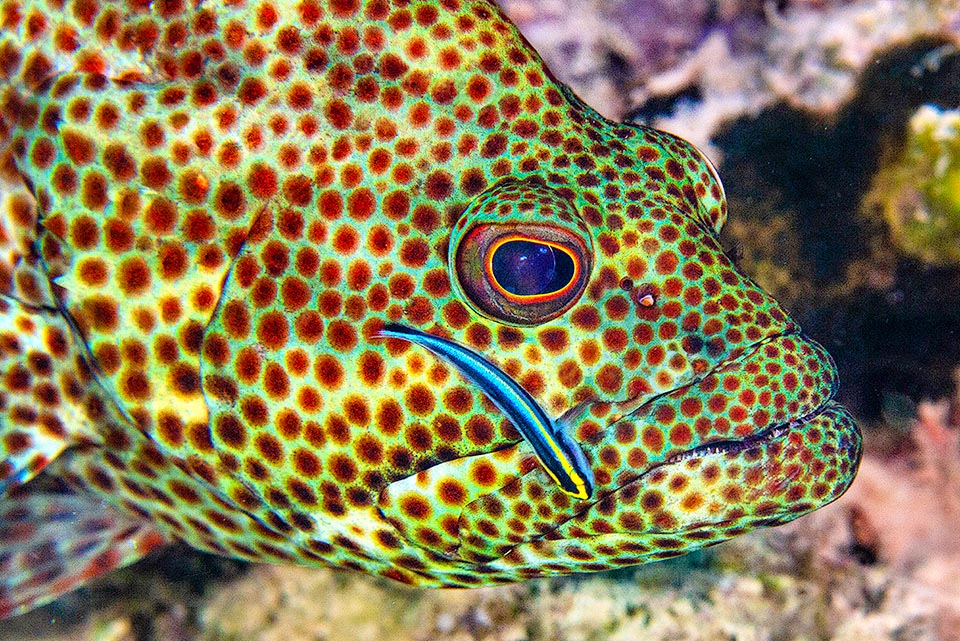
A clinic open to 47 species of fishes belonging to 17 families, where also predators like the Graysby grouper (Cephalopholis cruentata) come to be treated © Douglas Klug
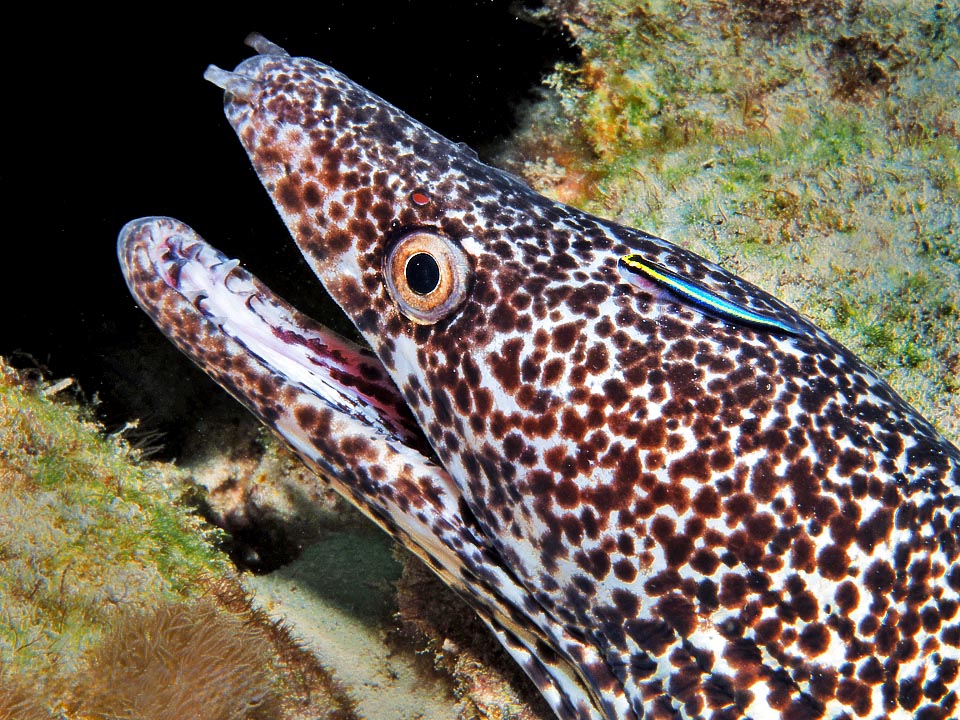
Moray eels are also there, like the ferocious Spotted moray (Gymnothorax moringa) with its impressive teeth © Pauline Walsh Jacobson
A study carried out over 8 years in Tobago, has shown that the tiny Sharknose goby cares for at least 47 species belonging to 17 different families.
In its ambulatorium it frees them mainly from the isopods of the family Gnathiidae, thus replacing very well the cleaning labrids, completely absent in its seas.
Elacatinus evelynae is not a particularly territorial species. It accepts the colleagues of the area but lives in couples.
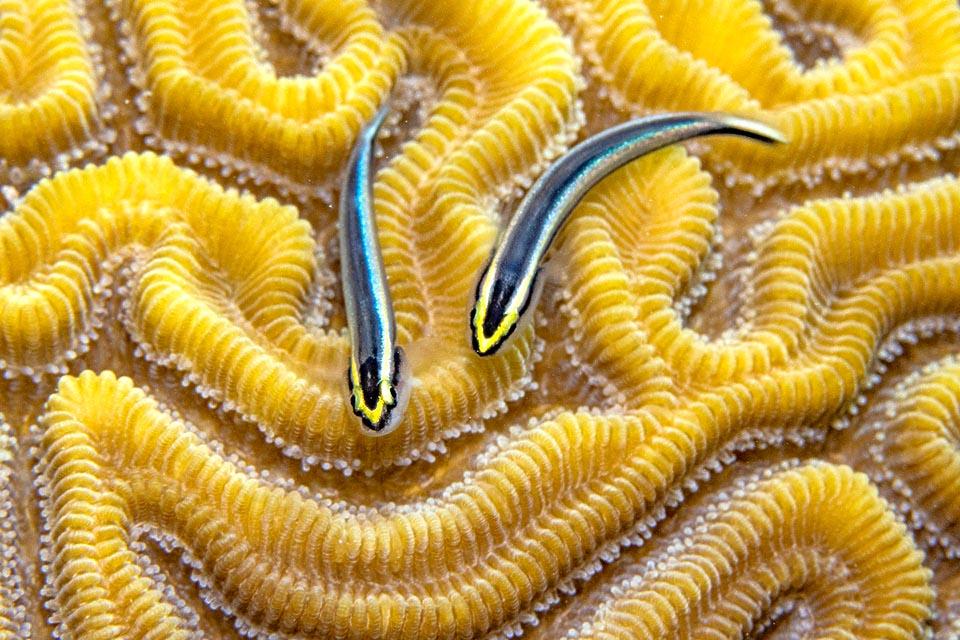
Elacatinus evelynae lives in couples. The tiny sticky eggs are glued to the ceiling of small cavities or in the shell of seashells, a nest surveyed until hatching © Allison & Carlos Estape
For reproducing these carefully clean a small niche close to home or inside a not far away abandoned shell, where the female lays tiny sticky eggs, not spherical, watched mainly by the male until hatching that usually occurs after 5-6 days.
A pelagic larval stage is missing and this could explain, as there are no long-range genetic exchanges, the birth of the three variants. The juveniles often grow close to the parents before dispersing into the surrounding area on other madrepores. They reach sexual maturity after about one year with a two years lifespan.
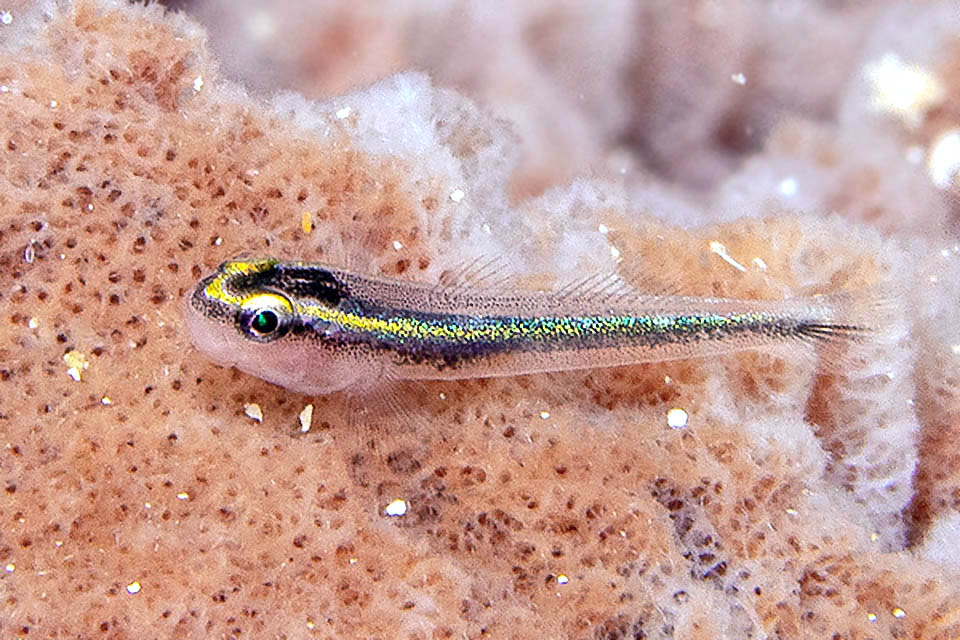
Juveniles then grow near their parents. They reach the sexual maturity after about one year and their lifespan is of two years © Allison & Carlos Estape
The Sharknose goby has reproduced in aquariums and are also found on the marketed breeding hybrids.
The resilience is high with a possible doubling of the populations in less than 15 months. The fishing vulnerability, very low, marks just 10 on a scale of 100. Elacatinus evelynae consequently appears as “LC, Least Concern”, that is “Minimal worry”, in the IUCN Red List of the endangered species. However, the global threat linked to the degradation of the reefs is looming.
Synonyms
Gobiosoma evelynae Böhlke & Robins, 1968.
→ For general information about FISH please click here.
→ For general information about BONY FISH please click here
→ For general information about CARTILAGINOUS FISH please click here.
→ To appreciate the BIODIVERSITY of BONY FISH please click here.
→ To appreciate the BIODIVERSITY of CARTILAGINOUS FISH please click here.
